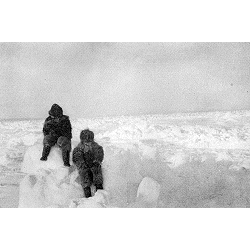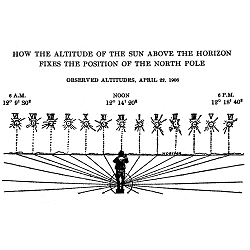| |
|
|
|
|
|
|

 |
 |
 |
At the Pole, Cook set the thickness of the ice at 16 feet, a very common measurement in the central polar basin cited in other narratives, including Nansen's. Cook correctly said the ice drifted southeast over the Pole, but this might have been deduced from the drift course of the Fram.
About the only original scientific observation Cook published was to say that his magnetic compass pointed south toward the magnetic pole along the 97th meridian when he was at the North Pole. We now know from computer models that in 1908 the magnetic compass would have pointed along meridian 133 degrees 28.8 minutes west + or – 0.5 degrees. This leads to the logical conclusion that Cook did not actually determine magnetic declinations. If he had done so, he would not have claimed that the compass pointed south along the 97th west meridian. Furthermore, there is no mention in his surviving notebooks that he did so, nor any observational record for magnetic declination among his papers.

Cook also places the temperature at the Pole ten degrees higher than south of it, in line with a long-held but incorrect contemporary scientific theory that the temperature would rise as the Pole was approached because of the constancy of sunlight.
Contemporaneous scientific theory also led Cook to believe that each pole was depressed about 13 miles to compensate for a perceived equatorial bulge of 26 miles. Today, satellites have revealed that instead of a depression, the earth bulges slightly at the North Pole—62 feet higher than if the earth were a perfect sphere. Given the theories of his time, however, perhaps Cook's only obvious gaff came in his description of the movements of the sun at the Pole—a concept, like celestial navigation and geomagnetism that requires a grasp of mathematical concepts. Such concepts always gave Cook trouble.
Cook originally described his observations of the sun at the North Pole like this: “In two days' observations it was determined that the sun circled the horizon always at the same elevation, from which resulted the only possible proof that the pole was actually reached.”
 |

Moreover, many of Cook’s more commonplace scientific observations about the central Arctic Ocean have proved incorrect. Cook said it was “a dead world of ice” . This was the popular view at the time, but the arctic pack is not a “sterile sea,” nor has it been so reported by travelers toward the Pole since 1908. Polar bears have been seen above the 88th parallel. Since bears sit at the top of the Arctic's food pyramid, their presence implies a complete chain of life below them.
As early as 1914, the Scottish Geographical Magazine summed up all the observations of Cook's polar narrative and found in them nothing startlingly original: “With a knowledge of Peary's Crocker Land, found in 1906, Peary's land ice near 86 degrees N., found the same year, and the experience in polar travel, which Dr. Cook certainly had, both in the Arctic and Antarctic, we submit that an imaginative man, taking into account probabilities, had an easy task in writing the story, and surely any man of even average education could write of the pole as ‘an endless field of purple snows. No life. No land.’
The more plausible hypothesis is that Cook never traveled as far north as the alleged Crocker Land, but turned back at or about the Big Lead and unwilling to admit defeat in the project which he asserts was his life's ambition, proceeded to write his story from the data previously outlined by Peary.”
| «- The Glacial Island | The westerly drift -» |